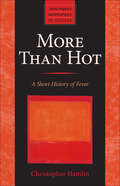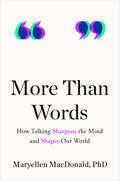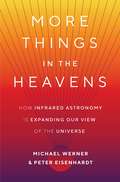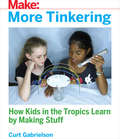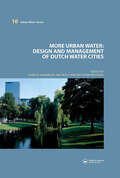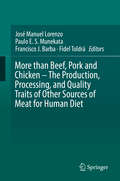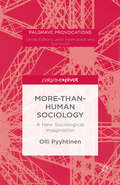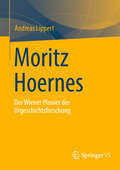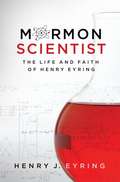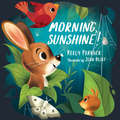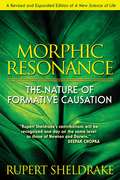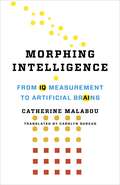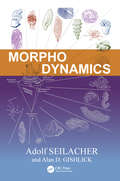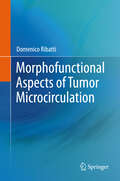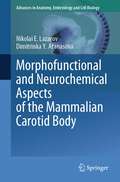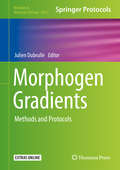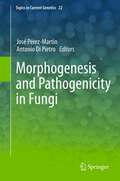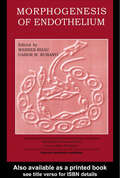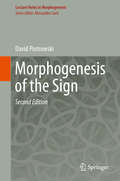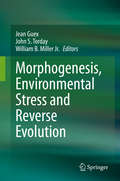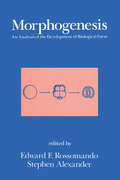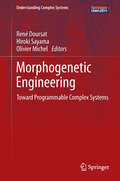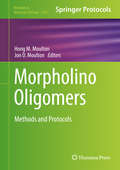- Table View
- List View
More Than Hot: A Short History of Fever (Johns Hopkins Biographies of Disease)
by Christopher HamlinA conceptual and cultural history of fever, a universally experienced and sometimes feared symptom.Winner of the CHOICE Outstanding Academic Title of the Choice ACRLChristopher Hamlin’s magisterial work engages a common experience—fever—in all its varieties and meanings. Reviewing the representations of that condition from ancient times to the present, More Than Hot is a history of the world through the lens of fever. The book deals with the expression of fever, with the efforts of medical scientists to classify it, and with fever’s changing social, cultural, and political significance. Long before there were thermometers to measure it, people recognized fever as a dangerous, if transitory, state of being. It was the most familiar form of alienation from the normal self, a concern to communities and states as well as to patients, families, and healers. The earliest medical writers struggled for a conceptual vocabulary to explain fever. During the Enlightenment, the idea of fever became a means to acknowledge the biological experiences that united humans. A century later, in the age of imperialism, it would become a key element of conquest, both an important way of differentiating places and races, and of imposing global expectations of health. Ultimately the concept would split: "fevers" were dangerous and often exotic epidemic diseases, while "fever" remained a curious physiological state, certainly distressing but usually benign. By the end of the twentieth century, that divergence divided the world between a global South profoundly affected by fevers—chiefly malaria—and a North where fever, now merely a symptom, was so medically trivial as to be transformed into a familiar motif of popular culture.A senior historian of science and medicine, Hamlin shares stories from individuals—some eminent, many forgotten—who exemplify aspects of fever: reflections of the fevered, for whom fevers, and especially the vivid hallucinations of delirium, were sometimes transformative; of those who cared for them (nurses and, often, mothers); and of those who sought to explain deadly epidemic outbreaks. Significant also are the arguments of the reformers, for whom fever stood as a proxy for manifold forms of injustice. Broad in scope and sweep, Hamlin’s study is a reflection of how the meanings of diseases continue to shift, affecting not only the identities we create but often also our ability to survive.
More Than Words: How Talking Sharpens the Mind and Shapes Our World
by Maryellen MacDonald PhD"This beautifully written book by Maryellen MacDonald demonstrates how 'word-work' shapes both our experience of the world and the very brain that produced our capacity to articulate and generate our best thoughts."—MARYANNE WOLF, author of Proust and the Squid and Reader Come HomeHumans are the only species that can transform internal ideas into talk, whether through speech, writing, or sign language. But why do we have this almost magical, special talent? It turns out that while talking allows us to share ideas and connect with one another, it isn&’t just for communication. Other benefits of talking stem from the fact that it is hard work: we can understand speech up to 50 percent faster than we can create it ourselves. The complex processes in the brain that allow us to talk spill over and impact other areas of our lives in surprising ways. In this groundbreaking book, Maryellen MacDonald, a researcher and psycholinguist, explores the marvel and mental task of talking and offers an eye-opening look at how it shapes everything from our attention, memory, and the way we learn to how we regulate our emotions and our cognitive health as we age. Filled with fascinating insights, More Than Words reveals:• how languages all over the world bend to the demands of talking• how talking helps us set goals and acts as a learning engine• the link between speech patterns and mental illness• why conversations in classrooms are crucial• how talking can amplify the talker&’s political polarization• how talking can slow cognitive decline as we ageEngaging and illuminating, More Than Words has lessons that have the power to transform education policy, parenting, psychology, and more. It is a sweeping and provocative look at a fundamental human behavior we take for granted.
More Things in the Heavens: How Infrared Astronomy Is Expanding Our View of the Universe
by Michael Werner Peter EisenhardtA sweeping tour of the infrared universe as seen through the eyes of NASA’s Spitzer Space TelescopeAstronomers have been studying the heavens for thousands of years, but until recently much of the cosmos has been invisible to the human eye. Launched in 2003, the Spitzer Space Telescope has brought the infrared universe into focus as never before. Michael Werner and Peter Eisenhardt are among the scientists who worked for decades to bring this historic mission to life. Here is their inside story of how Spitzer continues to carry out cutting-edge infrared astronomy to help answer fundamental questions that have intrigued humankind since time immemorial: Where did we come from? How did the universe evolve? Are we alone?In this panoramic book, Werner and Eisenhardt take readers on a breathtaking guided tour of the cosmos in the infrared, beginning in our solar system and venturing ever outward toward the distant origins of the expanding universe. They explain how astronomers use the infrared to observe celestial bodies that are too cold or too far away for their light to be seen by the eye, to conduct deep surveys of galaxies as they appeared at the dawn of time, and to peer through dense cosmic clouds that obscure major events in the life cycles of planets, stars, and galaxies.Featuring many of Spitzer’s spectacular images, More Things in the Heavens provides a thrilling look at how infrared astronomy is aiding the search for exoplanets and extraterrestrial life, and transforming our understanding of the history and evolution of our universe.
More Tinkering: How Kids in the Tropics Learn by Making Stuff
by Curt GabrielsonTinkering is a way of learning through hands-on activity -- experimenting with materials and devices to see how they work, taking things apart, making small changes and improvements, exploring and inventing. Tinkering may seem like a form of play -- and it is -- but it is also a powerful way of discovering truths about science, engineering, and math. With this book, Curt Gabrielson follows up on his best-seller Tinkering: Kids Learn by Making Stuff with this all-new volume that features more than three dozen fun and educational tinkering projects based on his years of working with kids in the tropical island nation of Timor-Leste. Step-by-step instructions accompanied by full-color photos take you through a range of enjoyable projects that explore life sciences, physics, chemistry, earth sciences, and mathematics. You'll discover how math is used to make baskets, how fungi create fermentation, how electricity can make a magnet, how the greenhouse effect creates warming, and much more. The author also enlivens his latest batch of tinkering projects with colorful tales of his experiences in the tropic and the lives of the people he' s met there.Inside you'll find:Clear directions for making simple projects and doing activities that teach science, mathematics and engineeringProjects rooted in day to day life and experience in a small, developing nation in the Asian tropicsFull-color photographs throughoutExplicit connections to standard STEAM concepts, K-12Activities doable with less than $5 worth of common materialsThis book is perfect for parents, teachers, and students with an interest in hands-on, tinkering-based science and mathematics education, whether in traditional schools or in home-schooling situations. It will also be of interest to anyone who wants to learn more about developing nations, the culture and unique history of Timor-Leste, tropical nations or Asian cultures, with specific links to Indonesia, Portugal, or Australia.
More Urban Water: Design and Management of Dutch water cities (Urban Water Series)
by Fransje HooimeijerAn integral approach to the relation of urbanism and water management in Dutch water cities and to adjustments necessary to upgrade water management systems to the requirements imposed by a changing amount or precipitation and by changing function, technology and scale of urban areas. Separate chapters deal with the transformation of the historical city, the consolidation of the inter-war city and the restructuring of the post-war city to meet future conditions. Comparisons of the Dutch situation with South Korean, Japanese and German urban areas is also included.
More than Beef, Pork and Chicken – The Production, Processing, and Quality Traits of Other Sources of Meat for Human Diet
by Fidel Toldrá José Manuel Lorenzo Paulo E. Munekata Francisco J. BarbaThis comprehensive work explores the demand, supply and variable consumer attitude toward a wide variety of unconventional and exotic animal species that are consumed in different parts of the world. Individual chapters focus on the consumption of horse meat, camel, buffalo, sheep, rabbit, wild boar, deer, goose, pheasant and exotic meats such as alligator, snake, frog and turtle. For each type of animal species, the carcass characteristics, physico-chemical properties and nutritional value of the meat are extensively outlined. The consumer preference, behavior and perception of each type of meat are also covered, with focus on important factors from sensory properties to psychological and marketing aspects. In promoting a better understanding of the complexities involved in consumer decision making, this book aims to improve the competitiveness of the meat industry through effective informational strategies that can increase consumer acceptance of more convenient, healthy and environmentally friendly meat choices.More than Beef, Pork and Chicken – The Production, Processing, and Quality Traits of Other Sources of Meat for Human Diet also focuses on the important role meat plays in the human diet and the evolution of the species. Beneficial factors such as protein, B complex vitamins, zinc, selenium and phosphorus are detailed. Negative factors are discussed as well, with issues such as fat and fatty acid content being addressed for each type of meat presented. In exploring the full range of nutritional benefits, consumer acceptance and carcass characteristics in a large quantity of different types of animal meats from all over the world, this book offers incredible value to researchers looking for a single source on unconventional meat processing.
More than Nature Needs
by Derek BickertonThe human mind is an unlikely evolutionary adaptation. How did humans acquire cognitive capacities far more powerful than anything a hunting-and-gathering primate needed to survive? Alfred Russel Wallace, co-founder with Darwin of evolutionary theory, saw humans as "divine exceptions" to natural selection. Darwin thought use of language might have shaped our sophisticated brains, but his hypothesis remained an intriguing guess--until now. Combining state-of-the-art research with forty years of writing and thinking about language evolution, Derek Bickerton convincingly resolves a crucial problem that both biology and the cognitive sciences have hitherto ignored or evaded. What evolved first was neither language nor intelligence--merely normal animal communication plus displacement. That was enough to break restrictions on both thought and communication that bound all other animals. The brain self-organized to store and automatically process its new input, words. But words, which are inextricably linked to the concepts they represent, had to be accessible to consciousness. The inevitable consequence was a cognitive engine able to voluntarily merge both thoughts and words into meaningful combinations. Only in a third phase could language emerge, as humans began to tinker with a medium that, when used for communication, was adequate for speakers but suboptimal for hearers. Starting from humankind's remotest past, More than Nature Needs transcends nativist thesis and empiricist antithesis by presenting a revolutionary synthesis--one that instead of merely repeating "nature and nurture" clichés shows specifically and in a principled manner how and why the synthesis came about.
More-than-Human Sociology: A New Sociological Imagination
by O. PyyhtinenMore-than-Human Sociology is a call for a bolder, more creative sociology. Olli Pyyhtinen argues that to make sociology responsive to life in the 21st century we need a new sociological imagination, one that addresses connectivity, understands the world in which we live as both a human and non-human world, and is sensitive to the multiple scales on which things exist. A fresh and innovative take on the promise of sociology, this book will appeal to scholars and students both within sociology and the social sciences more broadly.
Moritz Hoernes: Pionier der Urgeschichtsforschung
by Andreas LippertDer Band ist eine Biografie des ersten Lehrkanzelinhabers für Prähistorische Archäologie im deutschen Sprachraum. Nach einer längeren Zeit von Forschungen in Bosnien und der Herzegowina fand Hoernes eine Anstellung in der Prähistorischen Sammlung des Naturhistorischen Hofmuseums in Wien. Hier erst entschied er sich für urgeschichtliche Forschungen. Er habilitierte sich für das Fach 1892 und wurde bereits 1899 zum außerordentlichen Univ.-Professor an der Universität Wien ernannt. 1911 erfolgte dann seine Berufung als ordentlicher Univ.-Professor an dieser Universität. Hoernes verfasste einige bedeutende Übersichtswerke zur Urgeschichte in Europa, die noch heute Geltung haben, und zahlreiche Fachbeiträge.
Moritz Steinschneider. The Hebrew Translations of the Middle Ages and the Jews as Transmitters: Vol II. General Works. Logic. Christian Philosophers (Amsterdam Studies in Jewish Philosophy #18)
by Charles H. Manekin Hans Hinrich BiesterfeldtThis book surveys Hebrew manuscripts of Aristotelian philosophy and logic. It presents a translation and revision of part of Moritz Steinschneider’s monumental Die Hebraeischen Übersetzungen des Mittelalters und die Juden als Dolmetscher (The Hebrew Translations of the Middle Ages and the Jews as Interpreters). This resource was first published in 1893. It remains to this day the authoritative account of the transmission and development of Arabic and Latin, and, by way of those languages, Greek culture to medieval and renaissance Jews. The editors have updated Steinschneider’s bibliography. They have also judiciously revised some of his scholarly judgments. In addition, the volume provides an exhaustive listing of pertinent Hebrew manuscripts and their whereabouts. The section on logic, including texts hitherto unknown, represents the latest research in the history of medieval logic in Hebrew. This publication is the second in a series of volumes that translates, updates, and, where necessary, revises parts of Steinschneider’s bio-bibliographical classic work on Hebrew manuscripts of philosophical encyclopedias, manuals, and logical writings. Historians of medieval culture and philosophy, and also scholars of the transmission of classical culture to Muslims, Christians, and Jews, will find this volume indispensable.
Mormon Scientist: The Life and Faith of Henry Eyring
by Henry J. EyringThe lesson of Henry Eyring's life is that simple people, people just like you and me, can change the world. You do it every day, even without recognizing it. And you have the potential to change the world much more if only you can understand and use the gifts you have been given." --From the introduction by Steven M. Kuznicki Henry Eyring was one of the preeminent scientists of his era--no mean feat when you consider that his era included the likes of Einstein and Heisenberg. He was also a believing and practicing Latter-day Saint, an apparent contradiction that Henry mastered with surprising ease. To Henry, science and religion were not opposites--they were part of one unified picture that God would ultimately reveal. As a scientist, and as a man of faith, he worked at discovering the missing puzzle pieces that would make the picture complete. This engaging biography tells the story of a boy born on a ranch in the Mormon colonies of northern Mexico who attained the heights of scientific achievement, ultimately publishing more than 600 papers and leading the world's largest scientific societies. It is also the story of the family legacy that produced Henry Eyring--of the faith and sacrifice of his forebears that made his education and scientific achievements possible and laid the foundations of his own unshakable faith. Above all, this is the story of a scientist whose religious faith helped him find simple truths in a complex world. It is a legacy we can share as we learn from his experiences and apply his insights.
Morning, Sunshine!
by Keely ParrackAs we all wake up, the outside world bustles with life! Discover new facts about familiar creatures—from fluttering moths and scurrying beetles to shy foxes and humming bees—as they go about their morning activities. In the city, the countryside, and the suburbs, nature can be found everywhere!A series of haiku takes readers on a closeup, observational look at the amazing abundance of nature right outside our homes. Each stanza focuses on an aspect of the natural world or a creature going about their daily activities as the sun begins to rise. Alongside the haiku, informative text goes into depth about each subject—from how much honey a bee can make to the size of a hummingbird&’s egg. Instructions to help kids create their own haiku poems, a unique form of poetry from Japan, as well as a glossary add value for a STEAM and Core Curriculum book that can be enjoyed both in the classroom and at home.
Morphic Resonance: The Nature of Formative Causation
by Rupert SheldrakeNew updated and expanded edition of the groundbreaking book that ignited a firestorm in the scientific world with its radical approach to evolution • Explains how past forms and behaviors of organisms determine those of similar organisms in the present through morphic resonance • Reveals the nonmaterial connections that allow direct communication across time and space When A New Science of Life was first published the British journal Nature called it “the best candidate for burning there has been for many years.” The book called into question the prevailing mechanistic theory of life when its author, Rupert Sheldrake, a former research fellow of the Royal Society, proposed that morphogenetic fields are responsible for the characteristic form and organization of systems in biology, chemistry, and physics--and that they have measurable physical effects. Using his theory of morphic resonance, Sheldrake was able to reinterpret the regularities of nature as being more like habits than immutable laws, offering a new understanding of life and consciousness. In the years since its first publication, Sheldrake has continued his research to demonstrate that the past forms and behavior of organisms influence present organisms through direct immaterial connections across time and space. This can explain why new chemicals become easier to crystallize all over the world the more often their crystals have already formed, and why when laboratory rats have learned how to navigate a maze in one place, rats elsewhere appear to learn it more easily. With more than two decades of new research and data, Rupert Sheldrake makes an even stronger case for the validity of the theory of formative causation that can radically transform how we see our world and our future.
Morphing Intelligence: From IQ Measurement to Artificial Brains (The Wellek Library Lectures)
by Catherine MalabouWhat is intelligence? The concept crosses and blurs the boundaries between natural and artificial, bridging the human brain and the cybernetic world of AI. In this book, the acclaimed philosopher Catherine Malabou ventures a new approach that emphasizes the intertwined, networked relationships among the biological, the technological, and the symbolic.Malabou traces the modern metamorphoses of intelligence, seeking to understand how neurobiological and neurotechnological advances have transformed our view. She considers three crucial developments: the notion of intelligence as an empirical, genetically based quality measurable by standardized tests; the shift to the epigenetic paradigm, with its emphasis on neural plasticity; and the dawn of artificial intelligence, with its potential to simulate, replicate, and ultimately surpass the workings of the brain. Malabou concludes that a dialogue between human and cybernetic intelligence offers the best if not the only means to build a democratic future. A strikingly original exploration of our changing notions of intelligence and the human and their far-reaching philosophical and political implications, Morphing Intelligence is an essential analysis of the porous border between symbolic and biological life at a time when once-clear distinctions between mind and machine have become uncertain.
Morphodynamics
by Adolf Seilacher Alan D. GishlickMorphodynamics is defined as the unique interaction among environment, functional morphology, developmental constraints, phylogeny, and time-all of which shape the evolution of life. These fabricational patterns and similarities owe their regularity not to a detailed genetic program, but to extrinsic factors, which may be mechanical, chemical, or b
Morphofunctional Aspects of Tumor Microcirculation
by Domenico RibattiBlood vessels of tumors display many structural and functional abnormalities. Their unusual leakiness, potential for rapid growth and remodeling, and expression of distinctive surface molecules mediate the dissemination of tumor cells in the bloodstream and maintain the tumor microenvironment. Like normal blood vessels, they consist of endothelial cells, mural cells and their enveloping basement membrane. Common features, irrespective of their origin, size and growth pattern, are absent hierarchy, formation of large-caliber sinusoidal vessels, markedly heterogeneous density, increased permeability, decreased and abnormal pericyte-endothelial cell adhesion, irregular basement membrane structure, and the incorporation of bone-marrow-derived endothelial progenitor cells in the microvasculature. A number of specific tumor endothelial markers have been identified, as well as chromosomal abnormalities. These markers may be used to deliver drugs specifically and selectively to the tumor microvasculature.
Morphofunctional and Neurochemical Aspects of the Mammalian Carotid Body (Advances in Anatomy, Embryology and Cell Biology #237)
by Nikolai E. Lazarov Dimitrinka Y. AtanasovaThis new volume of the book series Advances in Anatomy, Embryology and Cell Biology provides a complete and exhaustive overview of the morphofunctional organization of the mammalian carotid body, a polymodal chemosensory organ responsible for the maintenance of blood gas homeostasis. The authors review the state of the art of the neurochemical anatomy of carotid body´s cell populations with a special reference to their structural and neurochemical plasticity. The essential role of this organ in the generation, progression and maintenance of cardiorespiratory and metabolic diseases in humans and other mammals is presented. Finally, the book summarizes current knowledge on the stem cell niche in the mammalian carotid body and discusses its contribution to replacement cell therapy and other potential applications in translational research. This book represents an essential reading for physiologists, anatomists, cell, and developmental biologists, as well as physicians, veterinarians, and biomedical researchers.
Morphogen Gradients: Methods and Protocols (Methods in Molecular Biology #1863)
by Julien DubrulleThis detailed book presents methods focusing on the visualization of morphogen gradients, the analysis of their biophysical and biological properties, and the theoretical aspects underlying their functions. The study of morphogen gradients combines biophysics, cell and developmental biology, and applied mathematics approaches to understand their formation, their biological functions, and the prediction of their behavior in space and time, and this volume serves as a practical, hands-on guide to the field. Written for the highly successful Methods in Molecular Biology series, chapters include introductions to their respective topics, lists of the necessary materials and reagents, step-by-step, readily reproducible laboratory protocols, and tips on troubleshooting and avoiding known pitfalls. Authoritative and helpful, Morphogen Gradients: Methods and Protocols is an ideal collection for researchers in this vital area of study.
Morphogenesis and Pathogenicity in Fungi
by José Pérez Martín Antonio Di PietroInfectious fungal diseases continue to take their toll in terms of human suffering and enormous economic losses. Invasive infections by opportunistic fungal pathogens are a major cause of morbidity and mortality in immuno-compromised individuals. At the same time, plant pathogenic fungi have devastating effects on crop production and human health. New strategies for antifungal control are required to meet the challenges posed by these agents, and such approaches can only be developed through the identification of novel biochemical and molecular targets. However, in contrast to bacterial pathogens, fungi display a wealth of "lifestyles" and modes of infection. This diversity makes it extremely difficult to identify individual, evolutionarily conserved virulence determinants and represents a major stumbling block in the search for common antifungal targets. In order to activate the infection programme, all fungal pathogens must undergo appropriate developmental transitions that involve cellular differentiation and the introduction of a new morphogenetic programme. How growth, cell cycle progression and morphogenesis are co-ordinately regulated during development has been an active area of research in fungal model systems such as budding and fission yeast. By contrast, we have only limited knowledge of how these developmental processes shape fungal pathogenicity, or of the role of the cell cycle and morphogenesis regulators as true virulence factors. This book combines state-of-the-art expertise from diverse pathogen model systems to update our current understanding of the regulation of fungal morphogenesis as a key determinant of pathogenicity in fungi.
Morphogenesis of Endothelium
by Gabor M. Rubanyi Werner RisauThe cardiovascular system is the first functional organ system to develop in the vertebrate embryo. Embryonic growth and differentiation essentially depend on transport of nutrients and waste through the early vasculature, and certain events in morphogenesis are thought to be influenced by the hemodynamic forces of the beating heart. The vasculatur
Morphogenesis of the Sign: From Morphodynamics To Neurosciences (Lecture Notes in Morphogenesis)
by David PiotrowskiThis book develops a morphodynamical approach to linguistic and sign structures as an integrated response to multilevel and interrelated problems in semiolinguistic research. More broadly, the content is linked to the realities of living speech through a connection (via the concept of diacriticity) with the Merleau-Pontian phenomenology, and beyond the formal determinations of a semiolinguistic system and its calculus. Such problems are mainly epistemological (concerning the nature and legitimate scope of semiolinguistic knowledge), empirical (concerning the observational device and the data’s composition), and theoretical (regarding the choice of a conceptual and formalized explicative frame). With regard to theory, the book introduces a morphodynamical architecture of linguistic signs and operations as a suitable mathematization of Saussurean theory. The Husserlian phenomenological signification of this formal apparatus is then established, and, from an empirical standpoint, its compatibility with neurobiological experimental results is discussed.
Morphogenesis, Environmental Stress and Reverse Evolution
by William B. Miller John S. Torday Jean GuexIt is widely acknowledged that life has adapted to its environment, but the precise mechanism remains unknown since Natural Selection, Descent with Modification and Survival of the Fittest are metaphors that cannot be scientifically tested. In this unique text, invertebrate and vertebrate biologists illuminate the effects of physiologic stress on epigenetic responses in the process of evolutionary adaptation from unicellular organisms to invertebrates and vertebrates, respectively. This book offers a novel perspective on the mechanisms underlying evolution.Capacities for morphologic alterations and epigenetic adaptations subject to environmental stresses are demonstrated in both unicellular and multicellular organisms. Furthermore, the underlying cellular-molecular mechanisms that mediate stress for adaptation will be elucidated wherever possible. These include examples of ‘reverse evolution’ by Professor Guex for Ammonites and for mammals by Professor Torday and Dr. Miller. This provides empiric evidence that the conventional way of thinking about evolution as unidirectional is incorrect, leaving open the possibility that it is determined by cell-cell interactions, not sexual selection and reproductive strategy. Rather, the process of evolution can be productively traced through the conservation of an identifiable set of First Principles of Physiology that began with the unicellular form and have been consistently maintained, as reflected by the return to the unicellular state over the course of the life cycle.
Morphogenesis: An Analysis of the Development of Biological Form: An Analysis of the Development of Biological Form
by Stephen Alexander Edward F. RossomandoAn integrated reference which could form the basis for advanced courses on development or become a resource for individuals teaching basic courses. Following an introduction by the volume editors, the 11 chapters represent 11 different systems, arranged phylogenetically. This in-depth volume explores all the major morphogenic systems from bacteria to vertebrates. Presenting a comprehensive picture of the events and mechanisms that contribute to the development of the mature biological form. Written by internationally recognised authorities in the field ‘Morphogenesis’ provides novel insights into the function of multicellularity and morphogens in morphogenesis… details prokaryotic and eukaryotic systems as well as the more complex morphogenesis of mammals and birds…analyses the similarities and differences between the morphogenic strategies used by diverse organisms and identifies the unique advantages of each…describes basic concepts of each biological system, current research developments, and future directions in research…considers the impact on each system of gene function, the environment., pattern formation, and the intercellular communication and information transfer…examines that biochemical, molecular biological, and genetic approaches used to study each system and more. Generously referenced with more than 1525 bibliographic citations, ‘Morphogenesis’ is essential reading for molecular., cell, and developmental biologists; biochemists; microbiologists, and upper level undergraduate and graduate students in these disciplines.
Morphogenetic Engineering
by René Doursat Hiroki Sayama Olivier MichelGenerally, spontaneous pattern formation phenomena are random and repetitive, whereas elaborate devices are the deterministic product of human design. Yet, biological organisms and collective insect constructions are exceptional examples of complex systems that are both self-organized and architectural. This book is the first initiative of its kind toward establishing a new field of research, Morphogenetic Engineering, to explore the modeling and implementation of "self-architecturing" systems. Particular emphasis is placed on the programmability and computational abilities of self-organization, properties that are often underappreciated in complex systems science--while, conversely, the benefits of self-organization are often underappreciated in engineering methodologies. Altogether, the aim of this work is to provide a framework for and examples of a larger class of "self-architecturing" systems, while addressing fundamental questions such as > How do biological organisms carry out morphogenetic tasks so reliably? > Can we extrapolate their self-formation capabilities to engineered systems? > Can physical systems be endowed with information (or informational systems be embedded in physics) so as to create autonomous morphologies and functions? > What are the core principles and best practices for the design and engineering of such morphogenetic systems? The intended audience consists of researchers and graduate students who are working on, starting to work on, or interested in programmable self-organizing systems in a wide range of scientific fields, including computer science, robotics, bioengineering, control engineering, physics, theoretical biology, mathematics, and many others.
Morpholino Oligomers
by Hong M. Moulton Jon D. MoultonThis volume presents a historical perspective on Morpholinos, an overview of good Morpholino practices, techniques for controlling Morpholino activity with light, techniques for modulating microRNA activity in zebrafish embryos, probing genes during fin regeneration, methods for determining to structure of gene networks during development, electroporation, bacterial knockdowns, pretargeting, diagnostic applications of Morpholinos, techniques for delivering Morpholinos in utero to developing embryos, and methods offering rapid, hands-free, label-free and inexpensive assays of Morpholino concentrations in biological extracts. Written in the highly successful Methods in Molecular Biology series format, chapters include introductions to their respective topics, lists of the necessary materials and reagents, step-by-step, readily reproducible laboratory protocols, and tips on troubleshooting and avoiding known pitfalls. Morpholino Oligomers: Methods and Protocols aims to provide a diverse application of Morpholinos along with protocols that will assist new labs in moving the frontier.
